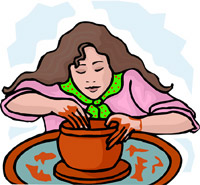1 Throwing a pot might sound like a person is mad, but that is what a potter does when he uses a pottery wheel. He isn't upset. He is creating art!
2 Pottery, or ceramics, has been around for a long time. The earliest pottery goes back to about 7,000 B.C. Ancient people did not have plastic, or metal, or glass. They used clay to make pots. Scientists who study ancient people are called archaeologists. They discovered homes from long ago with a lot of pieces of broken pots around. They put all the pieces together and learned a lot about the people who used the pottery. Some pots were small and deep. Others were tall and round. These people lived in Israel about 2,700 years ago. They did not use any cups or plates. They only used bowls!
3 Pottery is made with clay. Clay has tiny, flat particles in it. These particles are so small that hundreds of thousands of them can fit on the top of a pin! This tiny size and flat shape makes clay stick together when it is wet. Clay is found all over the world, so all civilizations used it to make pottery.
Paragraphs 4 to 5:
For the complete story with questions: click here for printable





